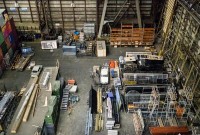- Home
- Business Processes
- Industry Knowledge
- Aerospace Industry
- Automotive Industry
- Banking Domain
- BFSI Industry
- Consumer/ FMCG Industry
- Chemicals Industry
- Engineering & Construction
- Energy Industry
- Education Domain
- Finance Domain
- Hospitality Domain
- Healthcare Industry
- Insurance Domain
- Retail Industry
- Travel and Tourism Domain
- Telecom Industry
- Leadership Skills
- eLearning
- Home
- Business Processes
- Order to Cash
- Cross Docking Process
Cross Docking Process
One of the warehousing best practices that retailers like Walmart, Amazon, and Target have adopted is known as cross-docking. During this process the inbound products are unloaded at a distribution center and then sorted by destination, and eventually reloaded onto outbound trucks. In real parlance, the goods are not at all warehoused but just moved across the dock (hence the name).
Cross-dock products from receiving warehouse to stores
One of the warehousing best practices that retailers like Walmart, Amazon, and Target have adopted is known as cross-docking. During this process the inbound products are unloaded at a distribution center and then sorted by destination, and eventually reloaded onto outbound trucks. In real parlance, the goods are not at all warehoused but just moved across the dock (hence the name).
Cross-dock is the process to distribute products from the receiving location of a purchase order to one or many stores. Cross docking takes place in a distribution docking terminal; usually consisting of trucks and dock doors on two (inbound and outbound) sides with minimal storage space. Cross docking can also be defined as the process of re- handling freight from inbound trucks and loading it into outbound vehicles. Essentially, cross-docking removes the “storage” link of the supply chain. Cross-docking is a practice in logistics of unloading materials from a manufacturer or mode of transportation directly to the customer or another mode of transportation, with little or no storage in between.
The receipt of products may be from multiple vendors and they are sorted in the receiving warehouse and dispatched in outbound trucks for a number of retail stores. Organization must specify the quantity being purchased of the selected product that should be distributed and orders are created from the receiving warehouse to the retail stores.
Factors influencing cross docking:
- Cross-docking requires continuous communication between suppliers, distribution centers, and final points of sale
- Useful when a single corporate customer has many multiple branches or using points
- Helps in reduction of freight costs, cost of inventory in transit and complexity of loads
Cross Docking Process:
Given below are the steps involved in designing a cross docking process:
- There are three parties involved in this process - Manufacturer of Originating Supplier, Supplier who has received the order from the customer.
- The originating supplier ships the goods.
- The supplier is notified of the shipping details.
- Carrier notifies middle supplier of the arrival date and time for each shipment.
- The supplier also receives the order details from the customer.
- The outbound carrier is notified of the pick-up time, load description, destination, and delivery date and time.
- The customer is notified of shipment detail, carrier, and arrival date and time.
- A dock location is selected for trucks involved in receiving and shipping.
- Labor and handling equipment are scheduled.
- Receipts are recorded and reconciled, and any receiving variances are noted.
- Labels are created, and cases and pallets are routed and tracked from receiving to dispatch.
Example:
This method was used by Wal-Mart in the 1980s. Wal-Mart was able to effectively leverage its logistical volume into a core strategic competency by usage of cross docking.
- Wal-Mart operates an extensive satellite network of distribution centers serviced by company-owned trucks
- They have two types of products, items for regular sales (staple stock) and large quantities of one time products
- Cross docking is used for second type of products
- It minimizes warehouse costs with direct freight by keeping these products in warehouse for as little time as possible.

Milk Run Process
A Milk Run is a delivery method used to transport mixed loads from various suppliers to one customer.
This method got its name from the dairy industry practice, where one tanker used to collect milk from several dairy farms for delivery to a milk processing company. The milk-run is generally an “in-warehouse” transportation system where your items are transported from a central or receiving area to different putaway areas within your facility. In the context of logistics, milk runs helps to increase the utilization of tools and in-turn reduce the logistics costs.
Examples:
- Some retail product quantities typically aren't full pallets of inventory. Milk-run strategy could be deployed for Putaway activity.
- One truck can visit multiple suppliers to pick up the loads for one customer.
Related Links
You May Also Like
-
Overview of Warehouse Processes
The basic function of a warehouse is to store goods. This means that they receive deliveries from suppliers, do any necessary checking and sorting, store the materials until it is dispatched to customers. Traditionally warehouses were seen as places for the long-term storage of goods. Now organizations want to optimize their customer experience and try to move materials quickly through the supply chain, so the role of warehousing has changed.
-
The Outbound process starts with routing the shipments. The Outbound execution process starts from the point when pick tasks are completed for an outbound shipment and ends at the point where the outbound packages are loaded into trailers. The Warehouse Outbound process includes managing and controlling outgoing materials starting from the download of orders through to the shipping of products from the warehouse.
-
What is the difference between Warehouse Management & Inventory Management?
The terms “inventory management” and “warehouse management” are sometimes mistakenly used interchangeably as they both deal with operations and products of industries. Despite their few similarities, there are many notable differences between warehouse and inventory management systems.
-
Types of Inventory Count Processes
While dealing with lots of inventory in a warehouse, lots of things can go wrong. Shipments may not have the right number of units in them, or they could get damaged somewhere along the supply chain. Discrepancies in the stock may arise as part of every inventory control, and need to be corrected immediately after the inventory control procedure has been finished.
-
One of the most important decisions when running a warehouse is its layout. Warehouse layout defines the physical arrangement of storage racks, loading and unloading areas, equipment and other facility areas in the warehouse. A good layout aligned with the business needs could have a significant effect on the efficiency.
-
Before shipping, businesses need to make sure that the items will arrive in good condition. Packaging is a form of protection against environmental threats that the product will face from the time it leaves warehouse facility until the time it reached the customer. The packaging is intended to provide protection for the item as it is being handled in the warehouse or when the item is being shipped.
-
In the normal course of business, customers are likely to return orders from time to time due to various reasons and business should design processes the manage and accept such returns. A well designed returns management process can reduce costs and issues associated with returns or exchanges.
-
When products arrive at a facility, there need to be a defined process to let them in. The process for accepting inventory when it arrives is called "Receiving". Any warehousing operation must be able to receive inventory or freight from trucks at loading docks and then stow them away in a storage location. Receiving often involves scheduling appointments for deliveries to occur, along with unloading the goods and performing a quality inspection.
-
Inventory is money, and hence businesses need to perform physical inventory counts periodically to make sure that their inventory records are accurate. The traditional approach to conducting inventory counts is to shut down a facility during a slow time of year to count everything, one item at a time. This process is slow, expensive, and (unfortunately) not very accurate.
-
Warehouses may seem like a simple, straightforward concept, but they actually include a variety of different types of warehouses that all have their own niche. The type of warehousing that’s right for you depends on your specific industry, location, and needs. From private warehousing, distribution centers, and climate-controlled warehouses, there’s an option to suit every business.
Explore Our Free Training Articles or
Sign Up to Start With Our eLearning Courses

About Us
Learning
© 2023 TechnoFunc, All Rights Reserved










